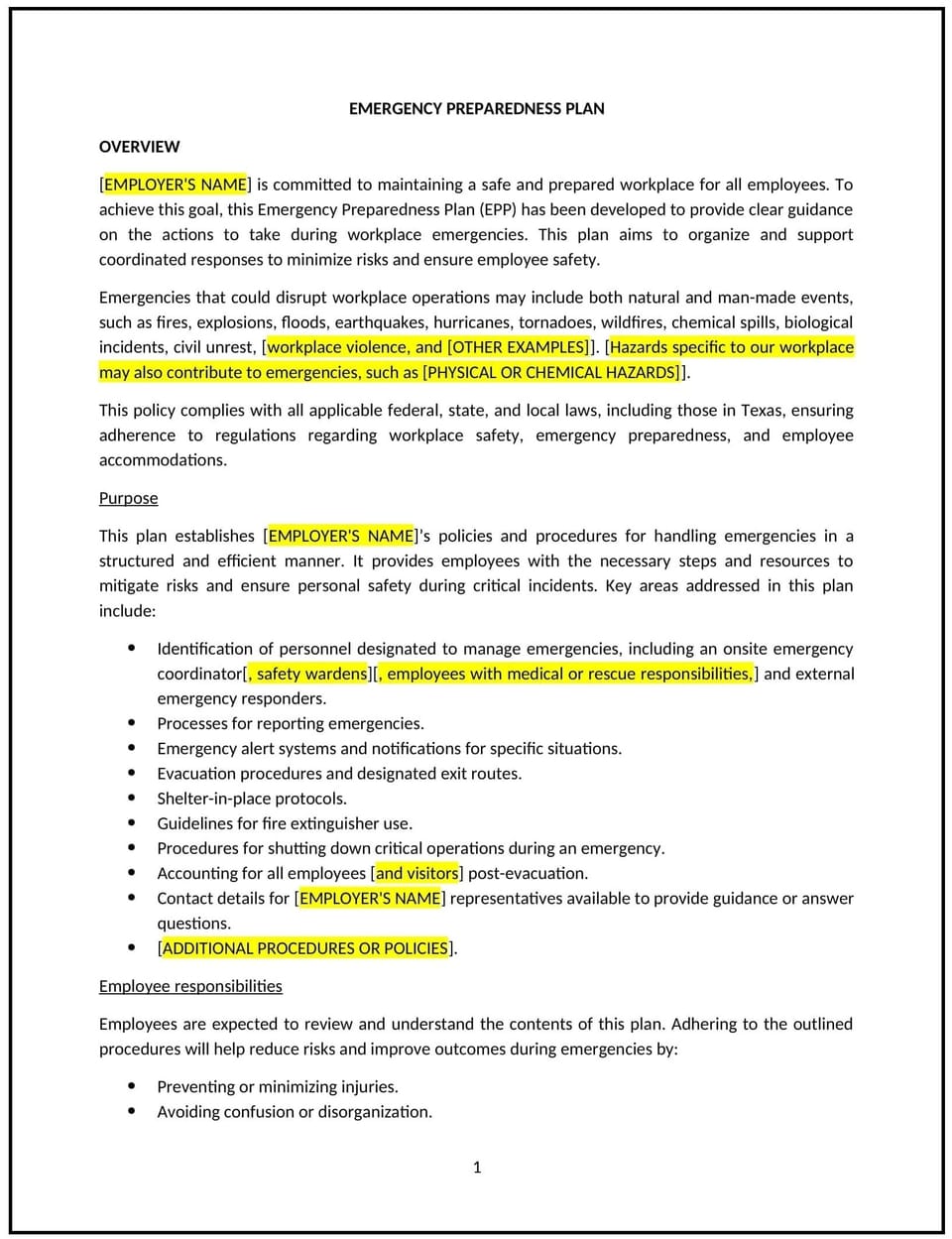Emergency preparedness plan (Texas): Free template

Emergency preparedness plan (Texas)
This emergency preparedness plan is designed to help Texas businesses establish clear procedures for responding to emergencies, ensuring the safety of employees, customers, and assets. Whether businesses are preparing for natural disasters, fires, medical emergencies, or workplace violence, this template provides a structured approach to managing emergencies in compliance with Texas state laws and federal regulations.
By adopting this plan, businesses can create a safer work environment, minimize risks, and improve their ability to respond quickly and effectively in emergency situations.
How to use this emergency preparedness plan (Texas)
- Identify potential emergencies: Clearly define the types of emergencies that may affect the business, including natural disasters (e.g., hurricanes, tornadoes), fires, medical emergencies, workplace violence, and other crises that could disrupt operations.
- Develop response protocols: Outline specific actions employees and management should take in the event of an emergency, including evacuation procedures, first aid, emergency contact information, and communication protocols.
- Establish emergency roles: Specify the roles and responsibilities of employees, supervisors, and managers during an emergency, ensuring that each individual knows their duties and how to contribute to the response.
- Address communication strategies: Develop clear communication plans, including how employees will be informed of emergencies, how updates will be provided during the crisis, and how to communicate with external emergency services.
- Provide training and drills: Include guidelines for regular emergency preparedness training and drills to ensure that all employees are familiar with procedures and know how to respond in an emergency.
- Review and update regularly: Establish a process for reviewing and updating the emergency preparedness plan regularly, ensuring that it remains current with changes in the business, local regulations, and new types of threats.
Benefits of using this emergency preparedness plan (Texas)
This policy offers several benefits for Texas businesses:
- Ensures safety: A well-established emergency preparedness plan helps protect employees, customers, and other stakeholders by ensuring that the business can respond quickly and effectively to emergencies.
- Minimizes disruptions: By having a plan in place, businesses can reduce downtime and resume operations quickly after an emergency, minimizing the impact on the organization’s bottom line.
- Reduces legal risks: A clear and compliant emergency preparedness plan helps businesses meet legal obligations under Texas state laws, OSHA requirements, and other regulations, reducing the risk of penalties or lawsuits.
- Improves employee confidence: Employees are more likely to feel safe and supported knowing that the company has a clear plan in place for emergencies, which can improve morale and retention.
- Enhances business continuity: An effective emergency plan contributes to overall business continuity, ensuring that the business can maintain or quickly resume operations in the face of an emergency.
Tips for using this emergency preparedness plan (Texas)
- Communicate the plan: Ensure that all employees are aware of the emergency preparedness plan, understand their roles, and know how to respond in an emergency situation.
- Conduct regular drills: Hold regular drills and training sessions to ensure that employees are prepared and know what to do in case of an emergency, including evacuation drills and first aid training.
- Create an emergency contact list: Maintain a current list of emergency contacts for local authorities, emergency services, employees, and business partners, and make sure it is easily accessible.
- Monitor potential threats: Stay informed about potential emergency situations in the region, such as weather events or health outbreaks, and update the plan as needed to address new risks.
- Review and update regularly: Regularly review and update the emergency preparedness plan to ensure it reflects changes in the business, workplace environment, or legal requirements.
Q: What types of emergencies should be covered by this plan?
A: The plan should cover a wide range of emergencies, including natural disasters, fires, medical emergencies, workplace violence, and other potential crises. The policy should specify the types of emergencies that apply to the business.
Q: How often should emergency preparedness training and drills be conducted?
A: Emergency preparedness training and drills should be conducted regularly, at least annually, to ensure that all employees are familiar with the procedures and can respond effectively in case of an emergency.
Q: Who is responsible for managing the emergency preparedness plan?
A: The policy should assign responsibility for managing and overseeing the emergency preparedness plan to a designated individual or team, such as a safety officer or emergency response coordinator.
Q: What should employees do during an emergency?
A: The plan should specify the actions employees should take during an emergency, including evacuation procedures, reporting emergencies, and following safety protocols. Employees should know how to communicate with emergency services and follow management instructions.
Q: How often should this policy be reviewed?
A: The policy should be reviewed annually or whenever there are significant changes in the business, local regulations, or new types of emergency threats that need to be addressed.
This article contains general legal information and does not contain legal advice. Cobrief is not a law firm or a substitute for an attorney or law firm. The law is complex and changes often. For legal advice, please ask a lawyer.


